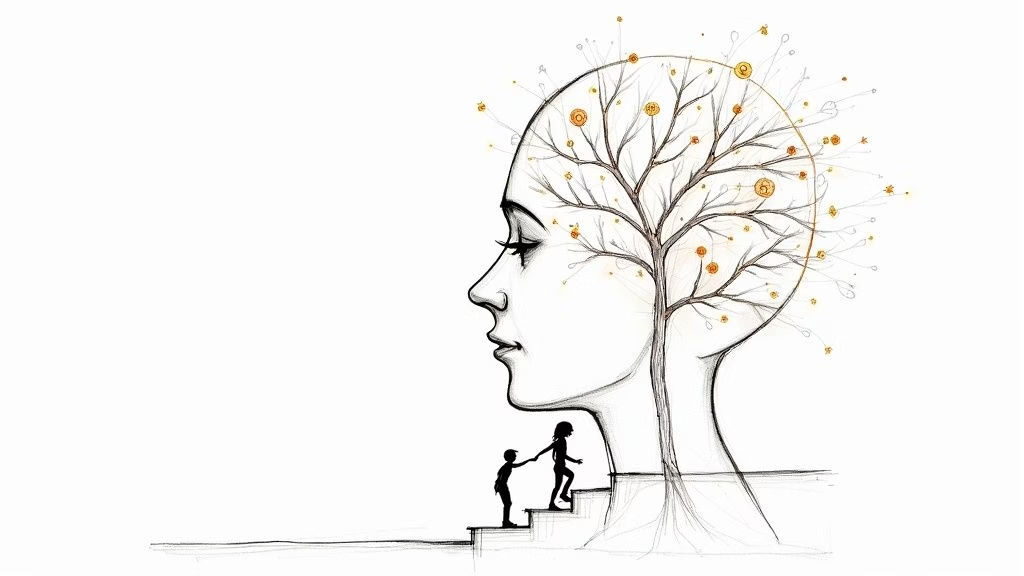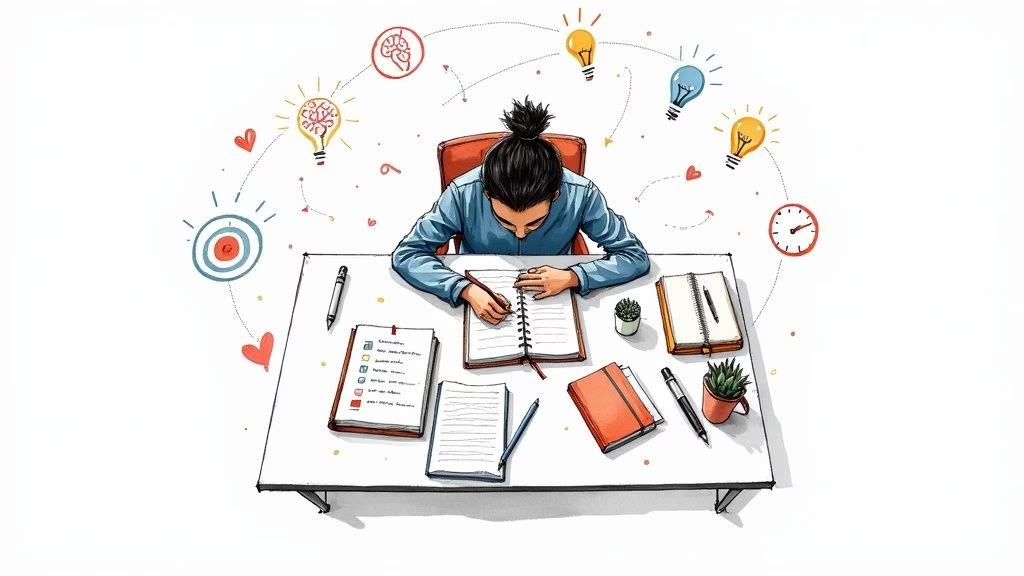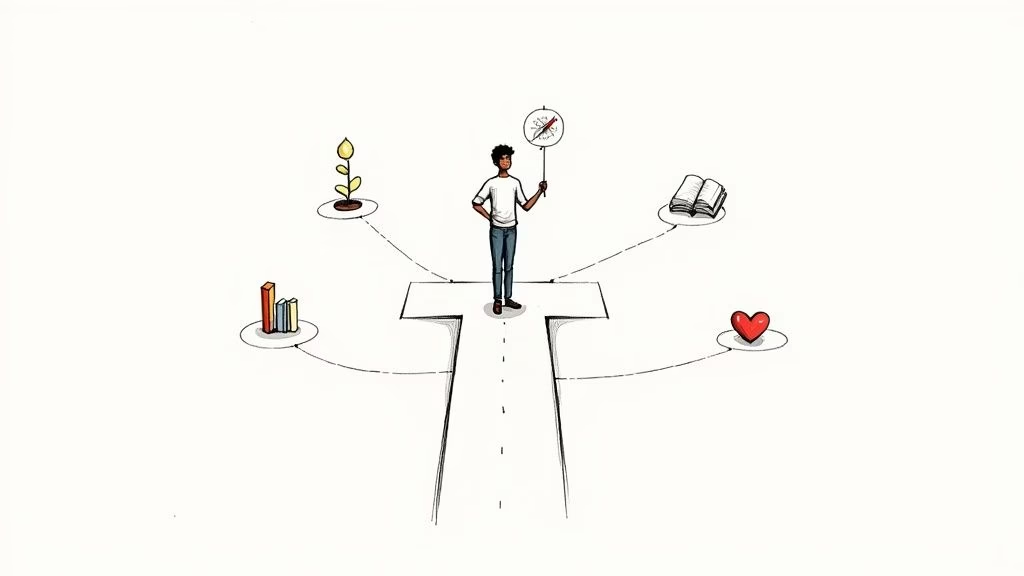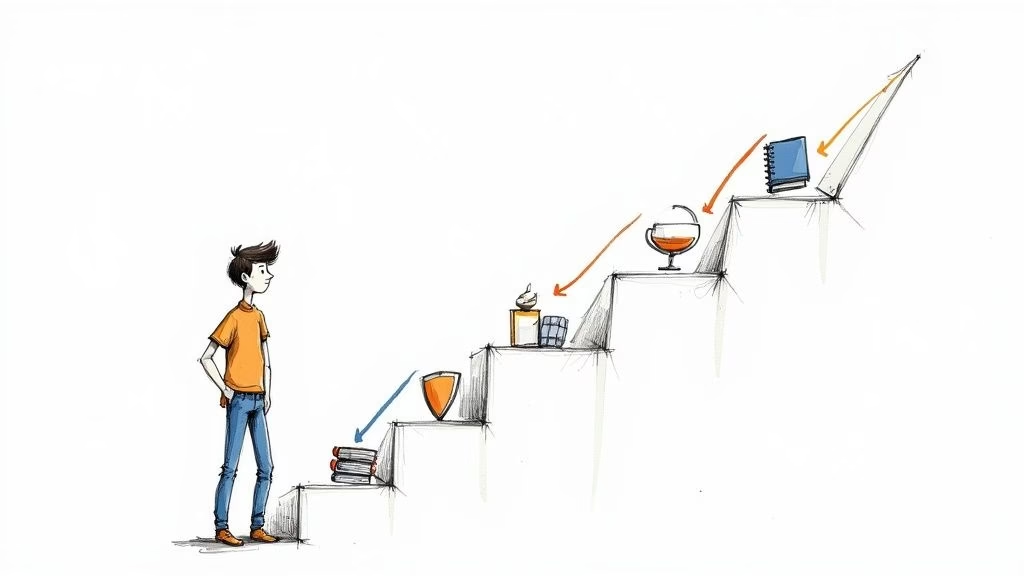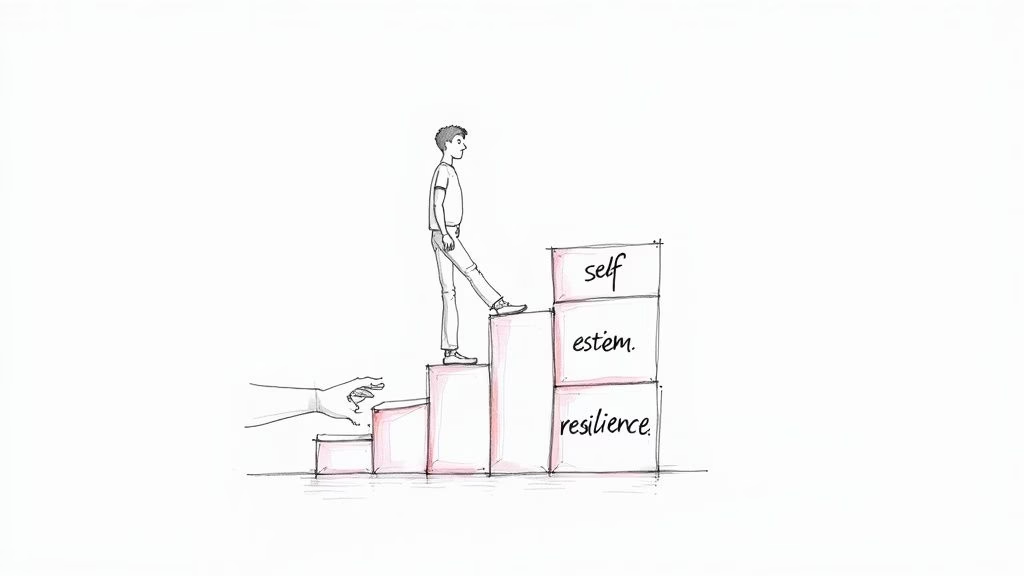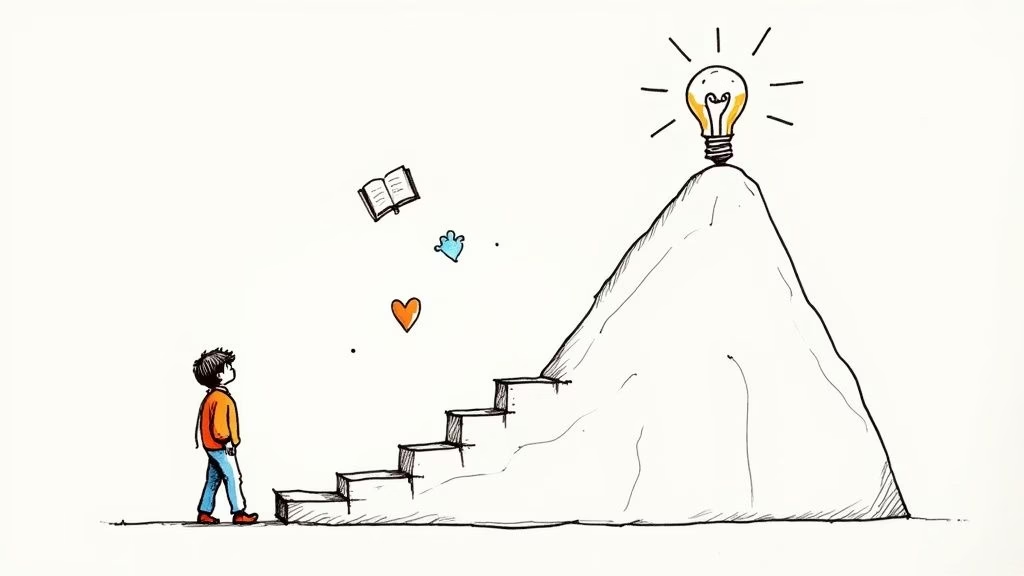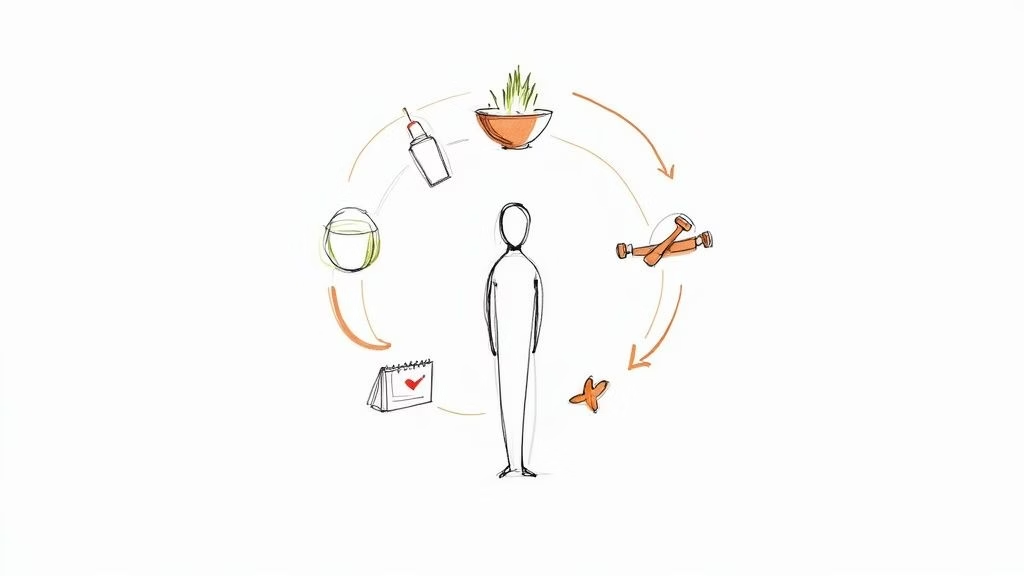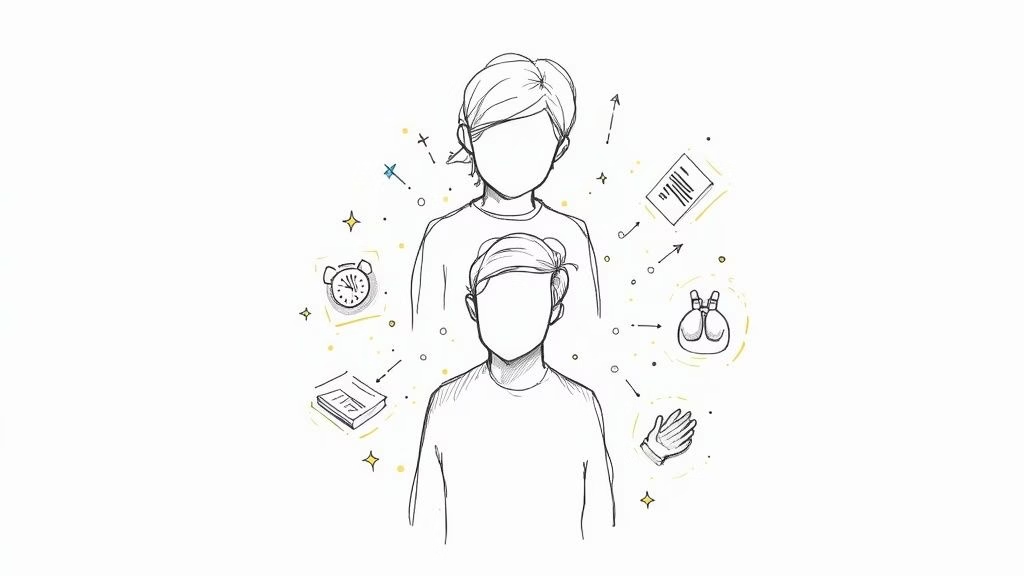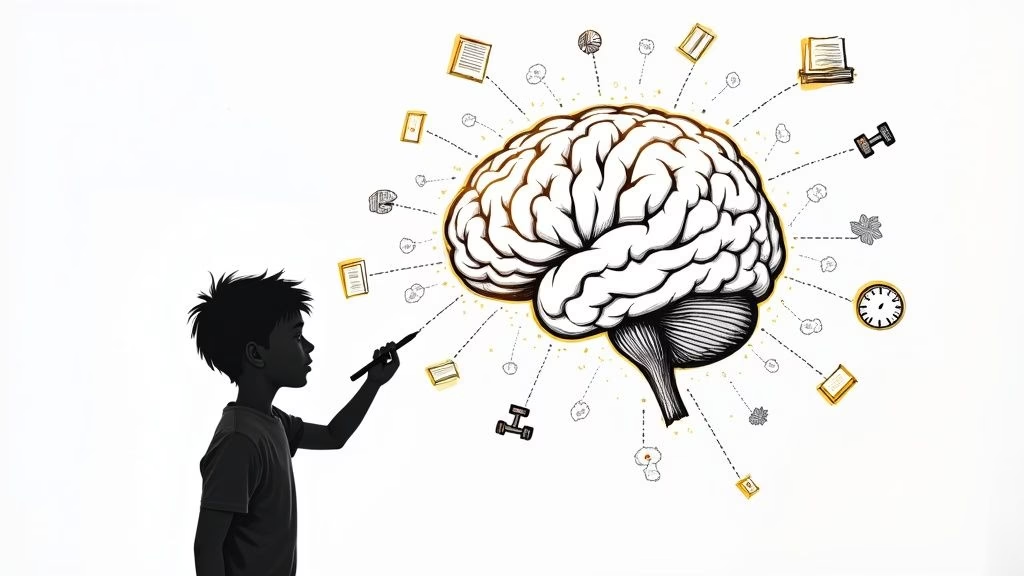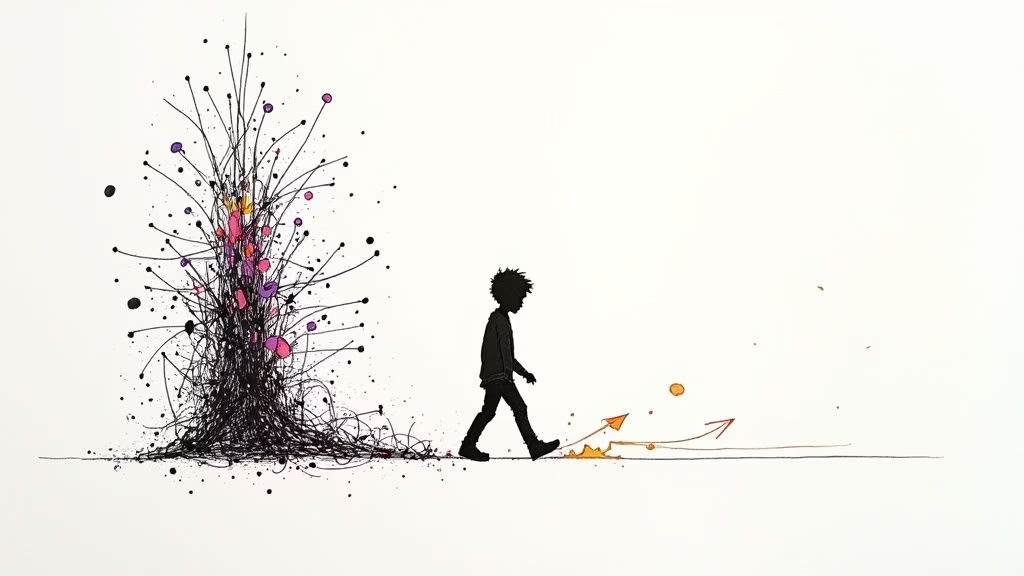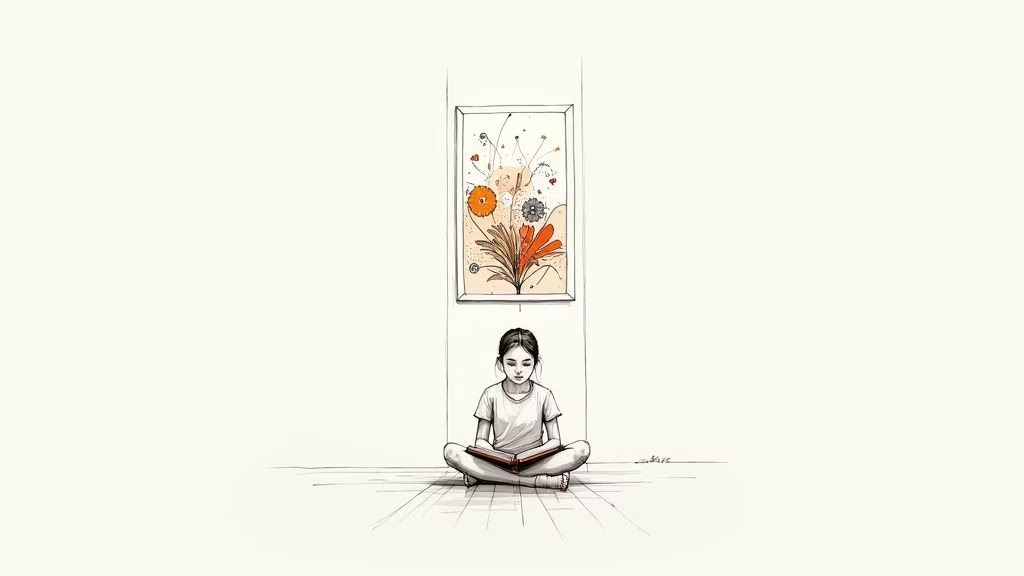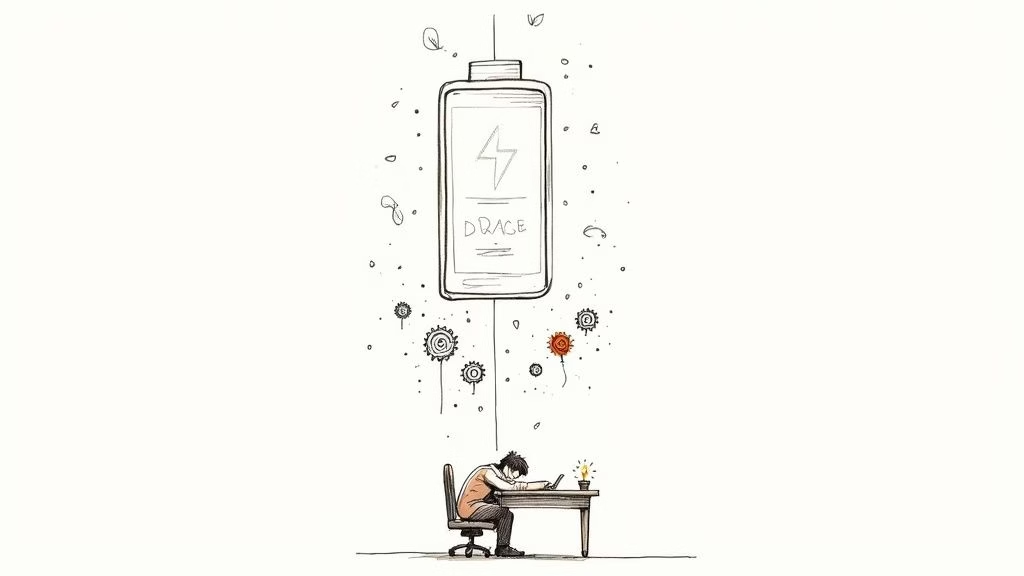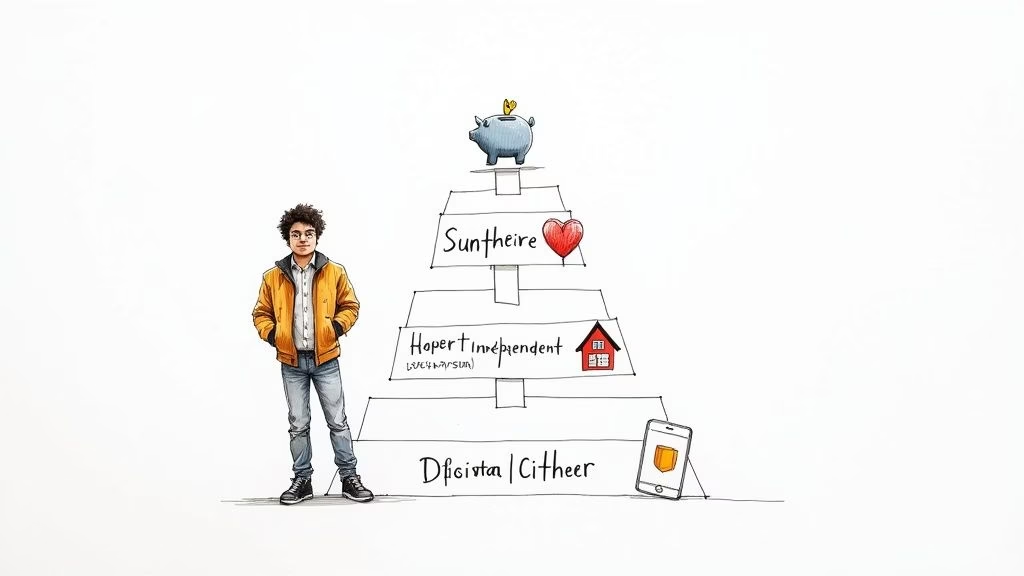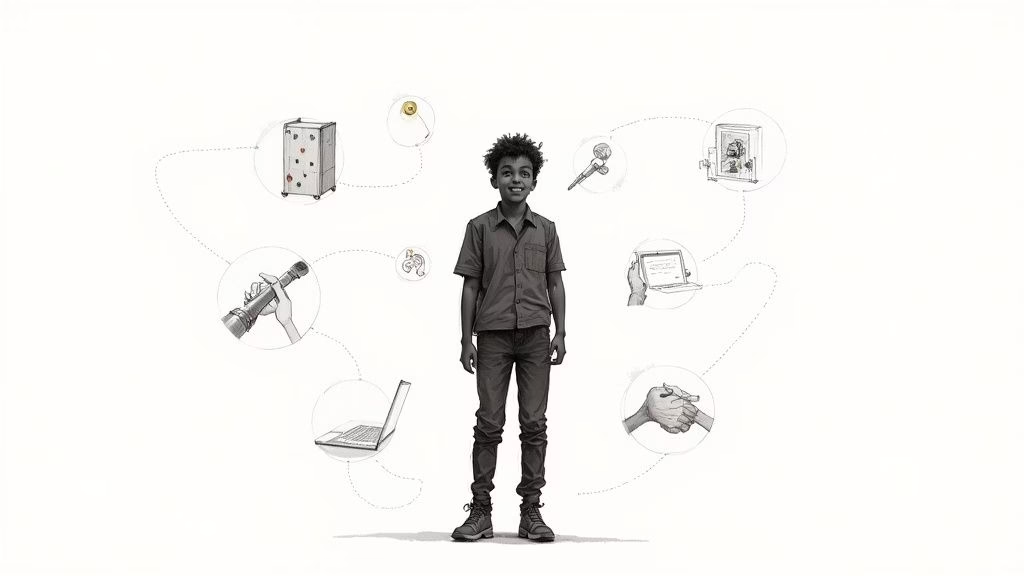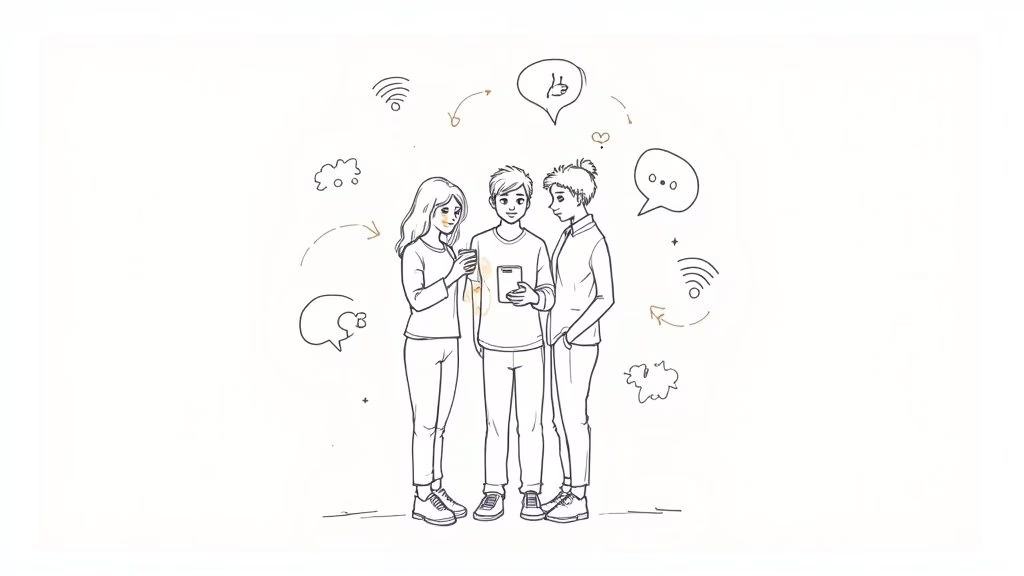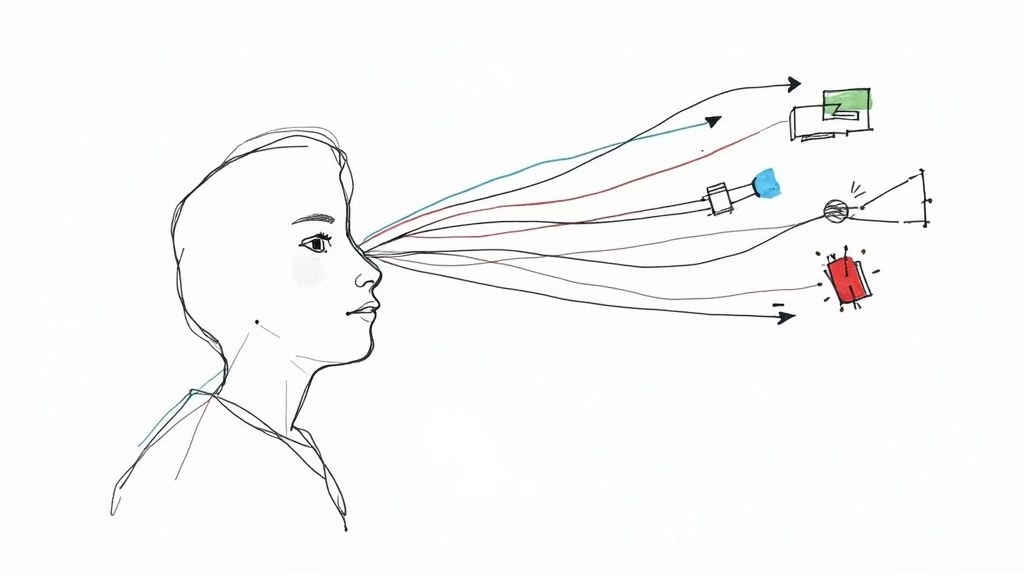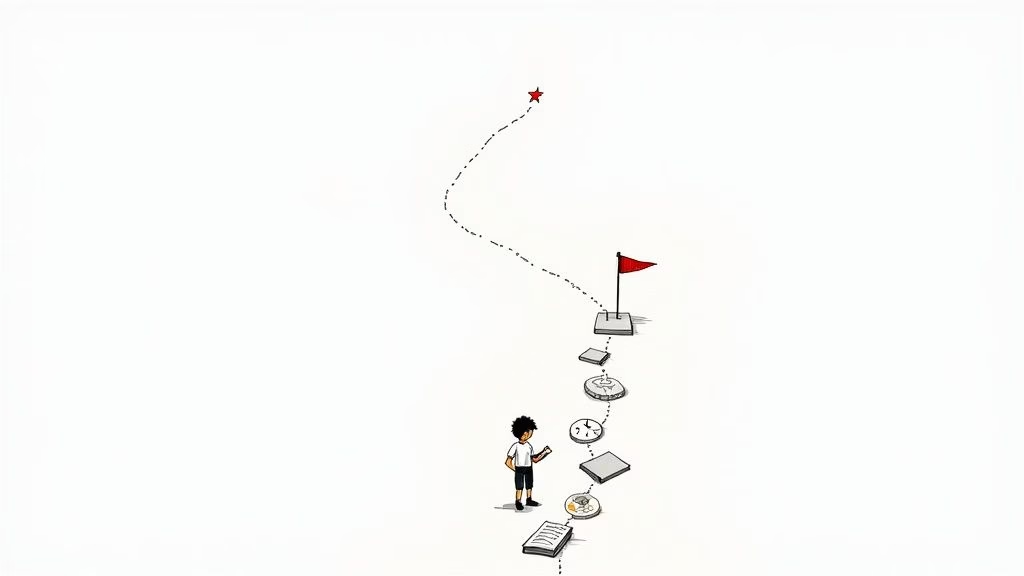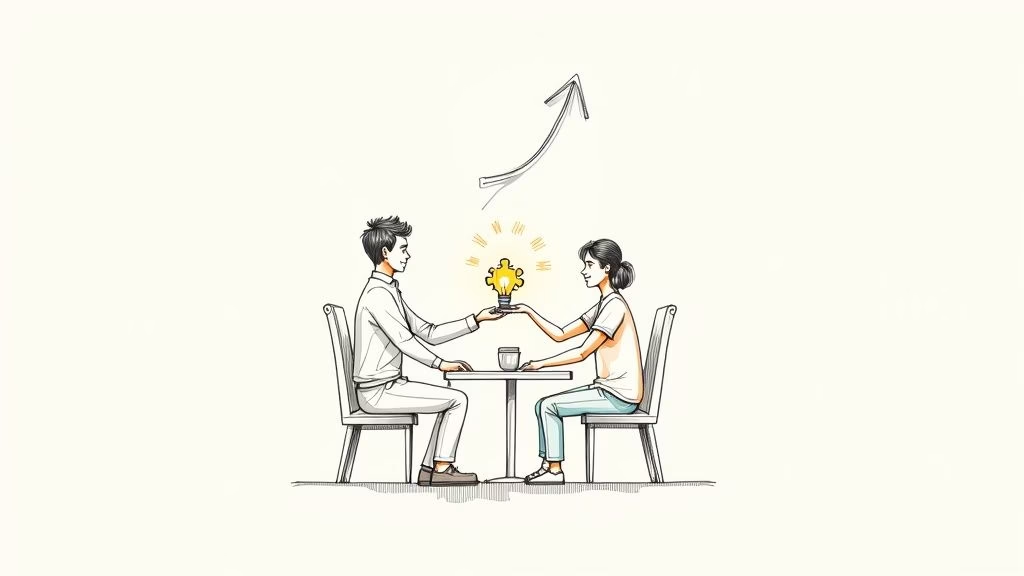Let's get one thing straight: building healthy habits has nothing to do with willpower. It’s a skill. And like any skill, you can learn it.
The whole process boils down to three things: a trigger (the cue), an action (the routine), and a positive feeling (the reward). Get that cycle right, and you're not just forcing a change—you're rewiring your brain to make success automatic.
Why Building Healthy Habits Feels So Hard

If you’ve tried to start a new habit and it didn't stick, you're not broken. You're normal. Think about all those New Year's resolutions to hit the gym or finally buckle down and study. The data shows that only about 9% of people actually pull them off.
The issue isn’t a lack of desire. The real problem is that our brains are wired for the easy way out—the path of least resistance. That path almost always leads back to our old, comfortable, and often unhealthy habits. We crave instant gratification, and new, healthy habits rarely offer that.
The Science Behind the Struggle
Every single one of our actions is driven by something called the habit loop. It’s a simple, three-part cycle running on autopilot in your brain. If you want to make a real change, you have to understand it first.
- The Cue: This is the trigger that kicks your brain into automatic mode. It could be a time of day (that 3 p.m. energy crash), an emotion (feeling stressed about a test), or even a place (walking into the school library).
- The Routine: This is the action you take, good or bad. For a teen struggling with a tough assignment, the cue of opening a textbook might trigger the routine of opening Instagram instead.
- The Reward: This is the payoff. Procrastinating provides a quick hit of relief and distraction from the discomfort of hard work. That reward is what cements the habit in place.
This loop is why breaking a bad habit feels like an uphill battle. You’re not just fighting an action; you’re fighting a deeply ingrained neurological reward system. This is especially tough for teens when academic pressure can make procrastination feel less like a choice and more like a survival mechanism.
Motivation isn’t some magical force that shows up when you need it. It’s usually the result of taking action, not the cause. When you feel unmotivated, the trick is to make the first step so ridiculously small that it’s impossible to say no.
When Motivation Dips and Procrastination Wins
That first wave of excitement for a new habit? It always fades. Always. This is the exact moment most people throw in the towel, convinced they've failed.
But fluctuating motivation is completely normal. Knowing it's coming is half the battle. For young men and teen boys, societal pressures can make it feel impossible to admit you're struggling, which just leads to feeling isolated. That’s why having a supportive environment is non-negotiable. If you're stuck in this cycle, it can be powerful to understand what causes a lack of motivation on a deeper level.
Parents, this is where you come in. Instead of asking, "Why didn't you study?" (which just triggers shame), try exploring the cue: "What were you feeling right before you picked up your phone?" This shifts the conversation from a battle of wills to a problem-solving session.
Once you understand these mechanics, you can stop fighting yourself and start building habits that actually last.
Create Your Personal Habit Roadmap
Real change starts with a plan that’s actually yours—not some generic template you found online. Knowing how to build healthy habits isn't about grand, sweeping declarations. It’s about creating a personal roadmap that feels authentic and gets you genuinely motivated. This is where you turn the vague idea of ‘getting healthy’ into a concrete, achievable plan you’re actually excited to follow.
The first step? Figure out what truly matters to you. Don't just say, "I want to be healthier." Go deeper. What does "healthier" really look like in your day-to-day life? Maybe it's having enough energy to get through a long school day without crashing, or maybe it’s feeling less stressed before a big exam.
Connecting a new habit to your core values is what makes it stick. It's the difference between a resolution that fizzles out by February and a change that lasts a lifetime.
Start with Micro Habits, Not Mountains
The biggest mistake I see people make is trying to do way too much, way too soon. We get a sudden burst of motivation and decide to overhaul our entire lives overnight—which is just a recipe for burnout. Instead, I want you to focus on micro-habits. These are small, manageable actions that build momentum without feeling overwhelming.
A micro-habit is an action so small it feels almost effortless.
- Want to start meditating? Your goal isn't to meditate for 30 minutes. It's to sit and focus on your breath for just 60 seconds.
- Feeling overwhelmed by a messy room? Don't plan to "clean your room." Your habit is to put one thing away when you walk in.
- Aiming to study more effectively? Instead of blocking out three hours, your starting habit is to open your textbook and read one page without distractions.
These tiny wins start to rewire your brain, helping it associate the new behavior with success, not struggle. This is especially powerful for teens dealing with procrastination. When a task feels monumental, the brain’s natural response is to avoid it. A micro-habit bypasses that defense mechanism completely.
Parenting Tips for Collaborative Habit Building
For parents, your role is to be a guide, not a drill sergeant. Forcing habits on a teen is a losing battle that usually just creates resistance. The key is to work with them, creating an environment where they feel in control of their own choices.
Instead of dictating goals, try asking open-ended questions like, "What's one small thing we could do this week that might make you feel less stressed about school?" or "If you had a little more energy, what would you use it for?" This approach fosters ownership and makes the process feel more like a partnership.
Encourage them to identify their own micro-habits and celebrate their consistency, no matter how small the action. Your job is to provide support and structure, helping them create a plan that truly feels like their own.
This visual breaks down the core process into three simple, actionable steps.

This process really drives home the point that defining a specific, measurable, and trackable goal is the foundation for any habit change that actually lasts.
Resources for Young Men and Mental Wellness
Building healthy habits goes far beyond physical health; it's deeply connected to your mental and emotional well-being. This is especially true for teen boys and young men, who often feel pressured to handle their struggles alone. Finding a supportive community can be a game-changer.
Men's groups like The Mankind Project or EVRYMAN offer incredible spaces for men to connect and build emotional resilience. These communities provide a powerful alternative to isolation, creating an environment where it's okay to be vulnerable and ask for support.
For any teen navigating mental health challenges on top of academic stress, there are great resources out there. Organizations like The Jed Foundation (JED) provide essential information and tools specifically designed to support the emotional health of teens and young adults. Remember, your roadmap should include seeking support when you need it—it’s one of the healthiest habits you can possibly build.
Engineer Your Environment for Automatic Success
Let's be honest: willpower is overrated. Relying on it to build good habits is like trying to hold back a flood with your bare hands. Sooner or later, you're going to get tired, and the old habits will rush right back in.
A much smarter approach? Engineer your environment so that good choices are the easiest ones you can make. Instead of constantly fighting your impulses, you set up your surroundings to nudge you toward your goals automatically.
This isn't just some self-help theory. The World Health Organization found that by the end of 2024, an estimated 1.4 billion more people were living healthier lives, not just because of individual choices, but because of large-scale environmental changes that made healthy living easier for everyone.
Set Up Your Space for Success
Your physical space is constantly sending signals to your brain, telling you what to do next. If you want to beat procrastination and stay motivated, your study space needs to minimize distractions and maximize focus. That means getting temptation out of your immediate line of sight.
- Create a Distraction-Free Zone: Is your phone the biggest black hole for your time? Don't just put it on silent. Move it to another room while you're working. That little bit of extra effort to go and get it creates a buffer, giving your disciplined mind a chance to step in.
- Make Your Cues Obvious: Want to work out in the morning? Don't leave it to chance. Lay out your gym clothes, shoes, and water bottle the night before. When you wake up and see everything ready to go, the decision to exercise feels almost effortless.
- Add Friction to Bad Habits: Trying to eat less junk food? Simple: don't keep it in the house. The effort of having to drive to the store is often enough to stop a craving in its tracks.
For parents, tweaking the home environment like this is a powerful way to support your teen without having to nag. For more ideas on this, check out my guide on setting up your teen's environment for success.
Harness the Power of Habit Stacking
One of the most effective ways I've found to build a new habit is to piggyback it onto one you already do without thinking. It's a technique called habit stacking, and it removes the need to find extra time or motivation in your already packed day.
The formula is simple: "After I [CURRENT HABIT], I will [NEW HABIT]."
The existing habit you already have becomes the trigger for the new one you want to build.
Example: You brush your teeth every single morning. It's automatic. If you want to start meditating to deal with school stress, your habit stack would be: "After I brush my teeth, I will meditate for two minutes."
It's a small, manageable addition that connects the new behavior to a pathway that's already wired into your brain.
A Simple Meditation Guide for Teens
Meditation can sound intimidating, but it doesn't have to be complicated. Here's a quick way to get started, especially after a long day at school.
- Find a Quiet Spot: Sit somewhere comfortable where you won't be interrupted. A chair is fine. You just need to be in a position where you won't doze off.
- Set a Timer: Start small. Just two or three minutes. Knowing there's an endpoint makes it feel way less daunting.
- Focus on Your Breath: Close your eyes and just notice the sensation of your breath. Don't try to change it, just observe it coming in and going out.
- Acknowledge Wandering Thoughts: Your mind is going to wander. That's what minds do. When you notice it, gently and without judgment, just bring your attention back to your breath.
This simple practice is a workout for your focus and a reset button for your nervous system.
And to keep yourself on track with fitness goals, digital tools can be a game-changer. There are some great guides on the best workout tracking apps that can help you monitor your progress and make your new habits stick.
Fueling Your Mind and Body for Lasting Change

True, lasting change isn’t just about tweaking your environment or your schedule. You can have the best intentions in the world, but if you’re running on empty, your habits won't stick.
Your mind and body are deeply connected. When one is struggling, the other feels it. That's why focusing on what you eat and how you manage stress can be a total game-changer for building good habits.
It’s the difference between pushing a boulder uphill and letting it roll with momentum. Simple shifts in nutrition and mindfulness can dramatically boost your energy, focus, and mood, making it far easier to follow through on your goals.
The trend toward healthier living is clear. By 2025, global consumers are increasingly prioritizing nutrient-dense, clean, and sustainable food choices. This isn't just a fad; poor nutrition is a huge barrier to building healthy habits because most modern diets simply lack the essential micronutrients our brains need to function at their best.
Nourish Your Brain and Body
Food is fuel—and not just for your muscles. It’s fuel for your brain's ability to stay motivated, fight procrastination, and handle stress. When you're consuming processed foods that cause energy crashes, a task like studying for a test feels ten times harder.
You don't need a restrictive diet. Just start making small, intentional choices. It’s about adding more of the good stuff.
- Add nutrient-dense foods: Think fruits, veggies, lean proteins, and whole grains. These give you a steady stream of energy, not the sharp spikes and crashes you get from sugar.
- Stay hydrated: Feeling foggy and irritable? You might just be dehydrated. Keep a water bottle handy and sip on it all day. It’s a simple fix that makes a big difference.
- Mindful eating: Pay attention to how different foods make you feel. When you notice the connection between a healthy meal and having great energy an hour later, that becomes a powerful motivator for change.
If you really want to get a handle on your eating patterns, learning how to keep an effective food journal is an invaluable tool. It gives you real data and helps you make more informed choices.
A Simple Meditation Guide for Teens
Mindfulness isn’t some mystical practice where you have to empty your mind. That's impossible. It's about learning to observe your thoughts without getting swept away by them.
For teens juggling school, social pressure, and everything else, a simple meditation practice can be a powerful way to dial down the stress and sharpen your focus.
Parenting Tip: Don't introduce meditation as another chore. Frame it as a "mental cooldown" after a tough day—a way to recharge their brain, just like they recharge their phone. It helps to join them for the first few sessions to make it feel more supportive and less like a solo assignment.
Here's a straightforward guide to get started.
A Simple Meditation Guide for Teens
Use this 5-step guide to start a mindfulness practice that reduces stress and improves focus.
| Step | Action | Focus Tip |
|---|---|---|
| 1. Find Your Spot | Sit comfortably in a quiet place. You can be on a chair with your feet flat on the floor or on a cushion on the ground. | The goal is to be alert yet relaxed, not to fall asleep. |
| 2. Set a Timer | Start with just three minutes. Knowing there’s a short, defined end time makes it feel much more manageable. | Use a gentle alarm sound to avoid a jarring end to your practice. |
| 3. Focus on Your Breath | Close your eyes and simply notice the sensation of your breath moving in and out of your body. Don't try to change it. | Feel the air at your nostrils or the rise and fall of your chest. |
| 4. Acknowledge Thoughts | Your mind will wander. That's its job. When you notice it, gently guide your attention back to your breath. | Think of your thoughts as clouds passing in the sky. Just watch them go. |
| 5. Be Kind to Yourself | There's no "perfect" meditation. The real practice is in the gentle act of returning your focus, again and again. | Each time you bring your focus back, you are strengthening your attention muscle. |
Remember, the point isn't to be perfect. The win is just showing up and trying.
Mental Health Resources for Teen Boys and Young Men
Building healthy habits takes mental resilience, but too many teen boys and young men feel like they have to tackle their struggles alone. Reaching out for support isn't a weakness—it's a sign of strength.
Destigmatizing mental health support is crucial. Finding a community where you can be open and honest is one of the most powerful things you can do.
Organizations like The Jed Foundation and Active Minds provide incredible resources for teens. For young men specifically, groups like HeadsUpGuys and The Man Cave offer supportive spaces that promote healthy emotional expression and provide real tools for managing mental well-being.
Sleep is also a massive piece of the puzzle. Understanding the connection between sleep and mental health for teens can offer huge insights into managing your mood and stress levels.
What to Do When You Inevitably Fall Off Track
Look, nobody's perfect. It's going to happen. You'll skip a workout, blow off a study session, or find yourself elbow-deep in a bag of chips you swore off last week. The immediate reaction for most of us is a wave of guilt, which can quickly convince you to throw in the towel altogether.
But here's the thing: a slip-up isn't a failure. It’s just feedback.
Building habits that stick isn't about maintaining a perfect streak; it's about building resilience. It’s about how fast—and how kindly—you can pick yourself up after getting knocked down. Getting this right is what separates a habit that fizzles out in a week from a genuine lifestyle change.
When you miss a day, there’s only one rule that matters: never miss twice in a row. One missed gym session is an accident. Two is the beginning of a new, less-than-ideal habit. Forgive yourself for the first one, and just get back to it the very next day.
Ditch Perfectionism and Aim for Progress
Your mindset is everything when you hit a snag. A perfectionist sees any mistake as a total failure, a reason to quit. But a progress-oriented mindset sees it as a completely normal part of learning something new.
"Okay, I messed up. What can I learn from this?" is a far more powerful question than, "Why am I such a loser?" The first question sparks growth. The second one just leads to shame.
To build this mindset, you have to celebrate the small wins. Did you stick to your plan for three days straight before things went sideways? That's awesome—acknowledge it. Grab a simple calendar or a habit-tracking app and give yourself a checkmark for every day you show up. Seeing that chain of successes makes you want to protect it and proves that one off-day doesn't erase all your hard work.
A Guide for Parents: How to Handle Your Teen's Setbacks
When your teen messes up on a new habit, your reaction can either build them up or tear them down. This is not the time for a lecture or a disappointed sigh. Instead, get curious and work with them.
- Make it normal: Let them know that struggling is part of the process. Tell them about a time you tried to build a habit and failed miserably at first. It shows them this is a universal human experience, not some personal flaw.
- Focus on the next step: Don't dwell on what went wrong. Shift the conversation forward. Ask, "What's one tiny thing you can do right now to get back on course?"
- Be a detective together: A slip-up is usually a clue that the plan needs a tweak. Was the "micro-habit" still too big? Was there a hidden trigger in their environment? Team up to figure out the real obstacle and adjust the plan.
This turns a moment of frustration into a powerful lesson in resilience and problem-solving—skills they'll need for the rest of their lives.
Adjusting Your Plan Without Feeling Like You Failed
Your habit plan isn't carved in stone. Think of it as a draft that's meant to be revised as you figure out what actually works for you. If you keep stumbling on the same habit, it's a clear sign that something in the strategy needs to change.
Ask yourself:
- Is my cue obvious enough?
- Is the routine itself too hard or too ambitious right now?
- Is the reward actually something I want?
Sometimes, life just changes, and your plan has to change with it. We're also seeing a shift where behavioral changes are supported by science. For instance, by 2030, it's estimated that 15 million obese patients worldwide will be using GLP-1 treatments—medications that help regulate appetite. This is a perfect example of modern science stepping in to support a behavioral goal, helping people build lasting habits when willpower alone isn't cutting it. You can discover more insights about health and nutrition trends for a deeper look at these changes.
For a teen who keeps procrastinating, a setback is a signal to reassess. If the goal to "study for two hours" fails every single night, shrink it. The new goal is "open the textbook for five minutes." That's it. The point is to get a win and build back momentum, no matter how small the step feels.
Building good habits is a long game. The bumps in the road are not failures; they're part of the journey. Learn from them and just keep going.
Support Resources for Teens and Young Men

Knowing how to build healthy habits is one thing, but figuring it all out alone is a heavy lift. Let’s be real: reaching out for support isn't a sign of weakness—it's a sign of strength. It's a crucial step toward creating change that actually sticks.
This is your curated hub of resources. Think of it as your back-pocket guide for when you need a little extra support. We’ve pulled together a list of respected mental health organizations and online communities that offer real, practical tools for teens and young men. These are places that get the challenges of managing school, motivation, and mental wellness.
Finding the Right Support System
For parents, opening up a conversation about mental health can feel like walking on eggshells. A great way to start is by exploring these resources with your teen. Frame it as a team effort—"Let's find some tools to help with the stress from school"—rather than "Let's fix this problem."
Your role isn't to be a therapist but to be a supportive ally. By normalizing the act of seeking help, you empower your teen to build one of the most important habits of all: advocating for their own well-being.
For teen guys and young men, finding a community that understands your specific pressures is a game-changer. Men's groups and initiatives focused on young men's mental health create spaces where it’s okay to be vulnerable. It’s where you can build emotional resilience without judgment.
This list is a launchpad. It’s a place to start finding the community and tools that will help you on your journey.
Mental Health and Support Resources
Here is a curated list of organizations and groups offering genuine support for teens and young men. These are solid places to begin your search.
| Resource Name | Primary Focus | Best For |
|---|---|---|
| The Jed Foundation (JED) | Emotional health and suicide prevention for teens and young adults. | Teens seeking educational resources and direct support for mental health challenges. |
| Active Minds | Mental health awareness and education on school campuses. | Students looking to get involved in advocacy and find peer support networks. |
| HeadsUpGuys | Depression resources and support specifically for men. | Young men seeking practical tips and real stories from others who have struggled. |
| The Man Cave | Preventative mental health and emotional intelligence programs. | Teen boys looking for workshops and communities that promote healthy masculinity. |
Take your time exploring what each one has to offer. The right fit can make all the difference in turning good intentions into lasting, positive change.
A Few Common Questions I Hear
When you're trying to build new habits, a few common roadblocks always seem to pop up. Here are some of the questions I get asked most, along with some practical ways to think about them for yourself, your teen, or your family.
"How Can I Help My Teen Son Who’s Struggling?"
This is a tough one. As a parent, seeing your son struggle with motivation or his mental health is incredibly painful. My first piece of advice is always to open up lines of communication without adding any pressure.
Instead of zeroing in on "fixing his habits," try to connect with him about his interests and find out what’s actually stressing him out. It’s often less about the habit itself and more about what’s going on underneath.
Finding a supportive community can also be a game-changer. Look for local men’s groups or even online resources like HeadsUpGuys, which is designed specifically to support young men’s mental health. The goal isn't to force a solution, but to give him access to positive role models and a space where being vulnerable is seen as a strength, not a weakness.
"How Do We Deal with Procrastination Around Schoolwork?"
First, let's get one thing straight: procrastination isn't laziness. It's almost always a reaction to feeling anxious or completely overwhelmed. To get past it, the key is to help your teen break down huge, intimidating assignments into tiny, almost ridiculously small steps.
The goal isn't to "finish the entire research paper." It’s to "write one paragraph." Or even just, "open the document and write the title."
Motivation doesn't come before action—it comes after. The smallest possible step is all you need to build momentum. Tell your teen to just start with a five-minute timer. More often than not, just getting started is the hardest part.
A simple meditation practice can also make a huge difference here. Introducing a quick, 3-minute mindfulness exercise can help manage that pre-homework anxiety before it spirals into avoidance. I often point families to guides from organizations like The Jed Foundation, which has great, teen-friendly techniques for improving focus. This isn't just about getting homework done; it's about building resilience and giving them tools to manage pressure for the long haul.
At Andrew Petrillo Life Coaching, my whole focus is on helping teens and young adults turn that feeling of being overwhelmed into clear, actionable steps. If your child is stuck in a cycle of procrastination or just can't seem to find their footing, let's work together to build a practical roadmap.
Find out how personalized coaching can make a real difference. You can book a complimentary discovery call right here: https://andrewpetrillolifecoaching.com.


